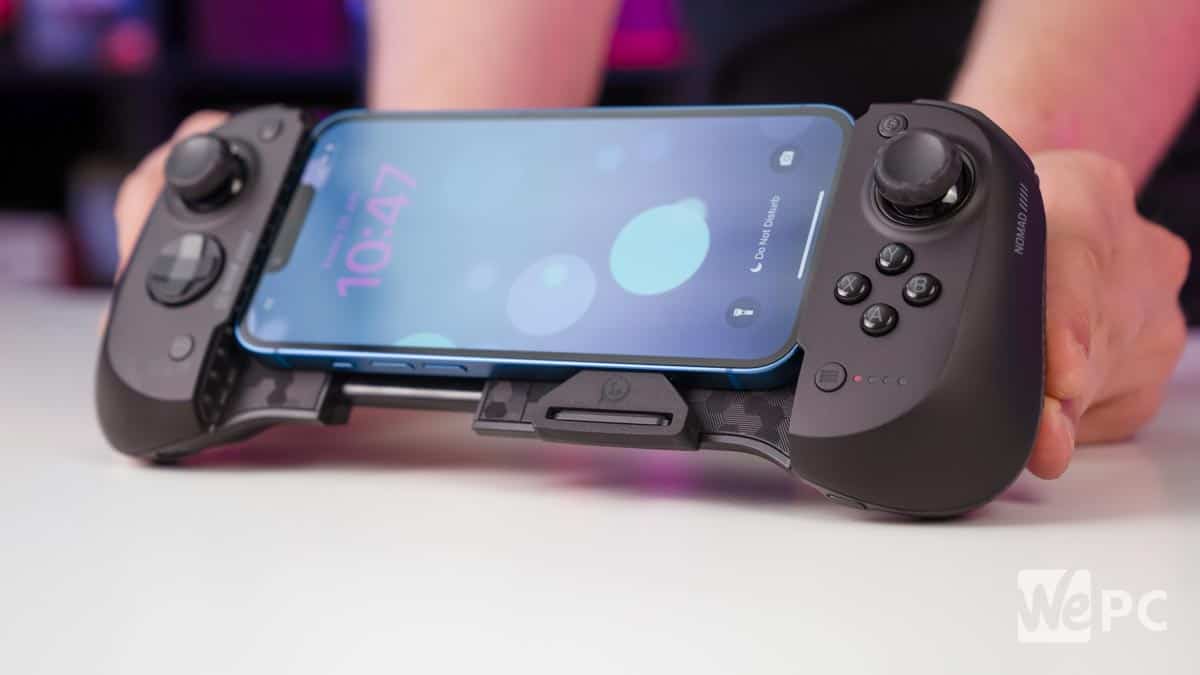

Last Updated: August 5th, 2024 The Scuf Nomad is a new design from the brand best known for their premium gaming controllers, which was acquired by Corsair back in 2019. This is a clamp-on style controller for iPhones only, though we’ve been informed by the company that they are looking to expand it to Android support at a later date (no promises though). We put the device through its paces, testing it in a variety of games. Let’s see how it compares to its main competitors: the Razer Kishi V2 for iPhone and the Backbone One. Specifications Compatibility: iOS 16+ (iPhone 8 onwards) Connectivity: Bluetooth 5.0 Weight: 228g / 0.5lbs Dimensions: 202 x 101 x 51 mm /7.95” x 3.98” x 2.01” What We Think A high-quality mobile controller with great build quality, ergonomic design (if you can get used to the joystick placement), and customization options in the integrated software. We would have liked to have seen pass-through charging and more connections beyond Bluetooth, but this does leave the door open for future Android compatibility at least. Note: A minority of users have reported input lag issues with the Bluetooth connection: we had no problems with our unit or on the games we played on so haven’t marked it down for this in our score, but we recommend having a read around before you pull the trigger. Hopefully this gets resolved in a future firmware update. Design & Features The Nomad is compatible with the iPhone 8 or later, and can extend wide enough to be able to fit the latest of the Pro Max line, and (depending on the size of the case in question) can actually fit a lot of phone cases as well, which is nice. Straight away anyone familiar with controller-based gaming will notice that the joysticks are placed unusually: with both sticks up at the top. This layout is seen on the Wii U and the Steam Deck however it’s still fairly uncommon. On the Razer Kishi, Backbone, and Xbox controllers the left stick is above the D-Pad but the right stick remains lower, below the face buttons, in an a-symmetrical configuration. PlayStation controllers do have a symmetrical joystick placement, but they are positioned below the D-Pad and the face buttons. Scuf have said that they’ve chosen this layout as it’s the ergonomically superior setup, offering better grip and control in first-person shooters, plus to encourage utilization of the back paddles for in-game actions alongside the bumper and trigger buttons on the top. The Hall Effect joysticks use magnets and electrical conductors rather than components that interact in contact with each other, which in practical terms means they have no dead zones, are immune to stick drift, and do not suffer as much from wear and tear. Besides this they are more precise and do not require as much pressure to move. Going back to the back paddles, they’re fairly unique in the mobile controller space at the time of writing, neither the Razer Kishi series nor Backbone have them, and they are nicely implemented into the body of the controller, feeling like an extension of it rather than a separate part loosely attached. Indeed the overall build quality of this controller is very nice. The majority of the chassis is made from a hard plastic, with rubberized grips on the back of the handles that is textured with the hexagonal SCUF logo pattern. It fits nicely in the hand and looks great too, with nice hexagonal detailing in the central extendable section (though you’ll only see this when you don’t have it attached to your phone). Color options come in black or white. In terms of connectivity, this is Bluetooth only, which as the benefit of meaning you don’t have to worry about the future compatibility of a physical connection, and does leave the door open to the (hopeful) future compatibility with Android devices down the line. The downsides are the lack of passthrough charging, so you can’t easily charge your phone as you play, plus the greater risk (though not necessarily) of lag – more on this below. Previous Next Software The Scuf Nomad App does not require a subscription or even much of a setup and is pretty top-notch, offering pretty much the same level of customization you’d find with other Scuf controllers. Here you can change the input sensitivity of your joysticks and their actuation and response curves and add deadzones, plus general button/paddle mapping, and you can save all this to different custom profiles that can be assigned to different games in your library. Besides this the app also includes built-in recording functionality, which allows you to record your gaming sessions with ease – not something you’d typically see. The whole interface of the software is easy to navigate and a pleasure to use. Previous Next Previous Next Price The SCUF NOMAD retails for $99.99, which makes it pricier than the main competition: in comparison the Razer Kishi V2 is now available for around the $80 mark brand new (or $60 renewed) and the GameSir G8 Galileo Type-C for $80. Neither of these devices have rear panels, Hall Effect joysticks, or the customization options the NOMAD does however, so we think this price difference is fairly reasonable all things considered. Performance Our experience of using the Scuf Nomad was very good: the hall effect joysticks felt super light and responsive despite being Bluetooth rather than USB C connected, although their positioning did take some getting used to. The right joystick being positioned above the face buttons is very different to any current control type on the market (handheld and console) and doesn’t feel totally natural (especially with 15 years+ of using controllers with that standard layout). Steam Deck users will be more at home though, and there’s no denying that the layout with the back paddles is better for first-person shooters (we tested Halo Infinite and Far Cry 5), if less so on platformers and the like. On titles like Spider-Man it felt a little difficult at first, however you can customise the trigger response in the Nomad app (my personal preference was linear with deadzones set to 1%). The D-Pad felt nice and responsive, though it is a bit on the smaller side, and all the other buttons felt good, including the paddles on the back – the trigger buttons were a bit stiff at first but once you get used to them they feel fine. The controller feels nice in your hands with the matte finish and rubber textured grips. Although overall we found the software to be top notch, the lack of native support of Gamepass within the app was one niggle we found: you can still use it of course, it’s just a bit less easily accessible. That being said, once we got it running we found no noticeable issues playing several titles on Gamepass. Remote play does have native support within the Scuf Nomad app, so you can jump right into it with ease, and it also ran well for us. One final thing that is important to consider in terms of performance is the Bluetooth connection: although we had no problems with latency from the joysticks it in our testing, however several other reviewers and consumers on Reddit have reported lag issues. This seems to vary by game and can sometimes be resolved with a restart of the phone. We hope for those that do experience it that future firmware updates from Scuf will resolve the problem.






